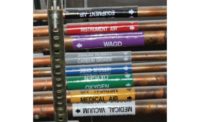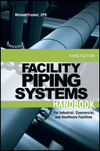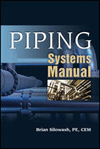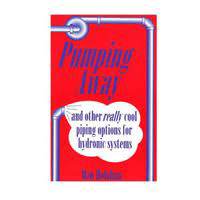
Issue: 4/03
Lately, it seems as if the codes and standards related to the design and installation of piped medical gas systems have been changing more quickly than the systems themselves can be designed and installed. With all of these changes how can you be sure the systems you are designing meet the latest requirements for safety and reliability required by the code and the functionality your clients demand?
The first and most important step is to understand how changes to the codes and standards affect your design and specifications. A complete discussion of the changes in requirements for the entire medical gas system (medical air compressors, valve stations, alarms, gas sources, etc.) could easily fill the pages of this magazine. We won't attempt to do that here. What we will discuss are changes that affect the medical gas piping itself.
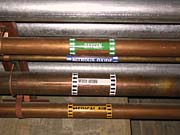
Piping Materials
Copper tube and fittings have long been acceptable and even preferred materials for the delivery of medical gases and compressed air in health care facilities and laboratories. To understand what changes have taken place in allowable piping materials we need to go back to 1987, when NFPA 56F, Standard on Nonflammable Medical Piped Gas Systems, was abandoned, and its requirements were incorporated into NFPA 99C, Standard on Gas and Vacuum Systems (an excerpt of NFPA 99, Health Care Facilities).The requirements for the piping in this 1987 edition of NFPA 99C reflected those of its predecessor: piping was to be either seamless copper tube manufactured to ASTM B 88 (Types K or L) or ASTM B 280 (Type ACR), or standard weight (Schedule 40) brass pipe. Fittings for joining the copper tubing were to be of copper, brass or bronze, and suitable for making brazed connections; those for joining the brass piping were to be of screw-type brass fittings, or bronze or copper brazing-type fittings.
In the 1993 edition of NFPA 99C, this was changed, and only seamless copper tube was allowed for use--brass pipe was no longer allowed. More importantly, however, was the fact that a specific type of copper tube had to be used. No longer could tube manufactured as standard water tube (ASTM B 88) or air conditioning field service tube (ASTM B 280) be used. Copper tube for medical gas systems had to meet the requirements of the new ASTM B 819, Standard Specification for Seamless Copper Tube for Medical Gas Systems.
This new standard provided a means for the manufacture, cleanliness testing and identification of a copper tube specifically for use in high-purity medical gas systems. Like the ASTM B 88 tube that preceded it, tube made to ASTM B 819 was also available in Types K and L, and in the same dimensions as the B 88 tube. The new standard required that specific internal cleanliness/residue limits be met, that the tube be delivered capped or sealed to maintain these limits, and that the tube be specially marked so that installers, inspectors and system verifiers could assure that installed copper tubing had been cleaned and capped by the manufacturer.
The requirements for copper fittings also changed. Following the 1993 edition, all turns, offsets and other changes in direction were to be made with brazed wrought copper capillary fittings complying with ANSI B16.22, Wrought Copper and Copper Alloy Solder-Joint fittings, or brazed fittings complying with MSS SP-73, Brazed Joints for Wrought and Cast Copper Alloy Solder-Joint Pressure Fittings. The standard went further to state that cast copper alloy fittings were no longer permitted.
While there have been a multitude of changes to the NFPA 99C standard since these changes of 1993, the basic requirements for the piping materials to be used for the medical gas piping have not changed. However, future changes are likely in the area of fittings.
With the recent publication of ASTM B 16.50, Wrought Copper and Copper Alloy Braze-Joint Pressure Fittings, late in 2001, it is likely we will see this standard introduced for use in medical gas systems in the near future. Unlike the MSS SP-73 standard that has been recognized since the NFPA 54 documents, the ASTM B 16.50 standard outlines the complete requirements for the manufacture of a wrought copper braze-joint fitting. The MSS SP-73 standard simply outlined the depth of the fitting cups necessary for someone to fabricate a braze-joint fitting from a previously manufactured solder-joint fitting.
Cleaned for Oxygen Service
There are a number of issues that have driven the changes we have seen in the NFPA 99C standard since the 1987 edition. One of the primary ones is system safety and cleanliness. To maintain system cleanliness, the 1987 edition required all piping materials and components to be cleaned of oil, grease and other readily oxidizable material as if for oxygen service, either prior to delivery or on-site. While the requirement for cleanliness for oxygen service has been maintained to this day, there has been a major change in how to achieve it.Prior to the 1993 edition, any piping component could be, and routinely was, cleaned on-site rather than by the manufacturer. Generally, this was accomplished through washing with a hot alkaline cleanser-water solution, such as sodium carbonate or trisodium phosphate, followed by a thorough rinse in clean, hot potable water. Performance of this vital cleaning step in the field lacked the quality control necessary to ensure proper cleaning, or more importantly, rinsing of the cleaning solution, which tended to result in residue from the cleaning solution in the installed piping.
The 1993 edition mandated that piping components could no longer be internally cleaned on-site, but had to be delivered to the site either cleaned by the manufacturer, or in the case of fittings, they could be cleaned by an outside agency other than the manufacturer. The only on-site cleaning allowed was for piping components cleaned by the manufacturer but which had become contaminated on-site, and this was restricted to tube ends (such as in the area of the joints)--not the entire length of tube, fittings or other components.
The use of ASTM B 819 copper tube, internally cleaned by the manufacturer and delivered capped to maintain this cleanliness, was a direct result of this requirement. On the other hand, copper fittings used for medical gas and other high purity systems were available that had been cleaned by the manufacturer, so a new copper fitting standard was not necessary. Nonetheless, it is important when specifying fittings for a medical gas system to require that they have been cleaned for oxygen service and bagged, capped or otherwise sealed to maintain this cleanliness until they are installed.
Brazer and Installer Qualifications
Also in an attempt to improve system safety and reliability, the 1993 edition of NFPA 99C began a series of changes to the requirements for system installation, as well as to brazer and installer qualifications, that has continued through the current 2002 edition of the standard. The 1993 edition was the first to include the requirement that all brazers on the medical gas system must be qualified in accordance with the requirements of either Section IX, Welding and Brazing Requirements of the ASME Boiler and Pressure Vessel Code, or AWS B2.2, Standard for Brazing Procedure and Performance Qualification, with some modifications as shown in the NFPA 99C standard.The current 2002 edition of NFPA 99C takes these qualification requirements a step further and requires that brazers continue to be qualified in this manner, but that installers must also meet the requirements of ASSE 6010, Medical Gas Systems Installers Professional Qualifications Standard.
The 2002 edition also introduced qualification requirements for maintenance personnel (ASSE 6040, Medical Gas Systems Maintenance Personnel Professional Qualifications Standard) and system verifiers (ASSE 6030, Medical Gas Systems Verifiers Professional Qualifications Standard).

Piping Specification Based on Facility Use/Level
The 1999 edition of NFPA 99C brought about the identification of medical facilities based on their usage/occupancy, and the requisite reliability and redundancy required for the medical gas systems. The 2002 edition further modified the definition of these facility levels. Facilities are divided into three levels, according to the following (more detailed definitions and requirements for these levels are shown in the standard):
- Level 1: Facilities where an interruption of the piped systems would place the patients in immediate danger of morbidity or mortality. This is usually limited to hospitals where patients are dependent for life on the gases or where mechanical ventilation is utilized at any time.
- Level 2: Facilities where an interruption in the piped systems would place the patients at manageable risk of morbidity or mortality. This is limited to facilities that stand apart from hospitals, are not interconnected to hospital medical gases, and the patients do not require mechanical ventilation or assisted mechanical ventilation, including during anesthesia.
- Level 3: Facilities where interruptions in the piped systems would terminate procedures but would not place the patients at risk of morbidity or mortality. The facility's total quantity of gases, except nitrogen, does not exceed 3,000 cubic feet, and only cylinders are used to supply oxygen and nitrous oxide to the facility (exception for cryogenic liquid oxygen). This is usually limited to occupancies like dental offices.
Depending on the reliability of the system required, each of the above levels has different requirements for gas sources, redundancy (duplex, simplex), compressors, filters, aftercoolers, alarms, regulators, etc. However, in most cases, the piping requirements for each level are the same, with the exception of the allowance for annealed tubing for underground, under-slab, or in-slab piping for Level 3 facilities.
In the 1999 edition of the standard, Level 3 facilities were allowed to use annealed temper, ASTM B 88 Type K or L copper tube where tube had to be run within a slab, although it stresses that wherever possible, copper tube shall be installed overhead or below floor level. The annealed tube must be cleaned for oxygen service and run within an appropriate conduit in the slab. An important distinction must be made here because this requirement departs from the change made in 1993 where only copper tube made to ASTM B 819 could be used. This departure was made because ASTM B 819 tube is not available in annealed temper, while B 88 tube is. However, since the B 88 standard does not require cleaning for oxygen service by the manufacturer, cleaning would have to be done on a special order basis or by an agency other than the manufacturer.
The more recent 2002 edition revised this requirement even further, inadvertently creating a discrepancy that you should be aware of when designing and specifying these Level 3 systems. Section 5.3.10.1.1, Piping for Medical Gases, requires that ASTM B 819 copper tube be used; however, Section 5.3.10.10.7, Piping Within Floor Slabs and Underground Within Buildings, states that for piping installed in a floor slab or underground within a building, annealed temper tube can be used. Since ASTM B 819 tube is not available in annealed temper, this creates a conflict that cannot be addressed by specifying materials that meet approved standards. The only way to meet all of the requirements of Section 5.3.10 of the 2002 edition of NFPA 99C and avoid possible code violations is to use straight lengths of hard drawn, ASTM B 819 copper tube with brazed joints, regardless of whether the tube is located under the slab, overhead or in the wall.
